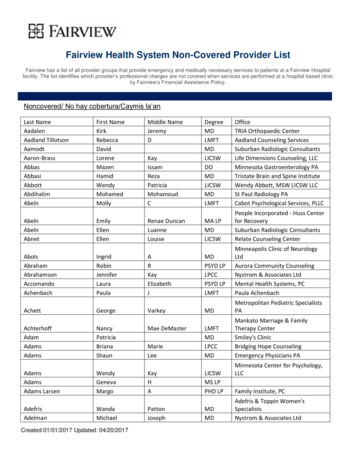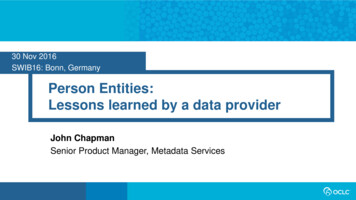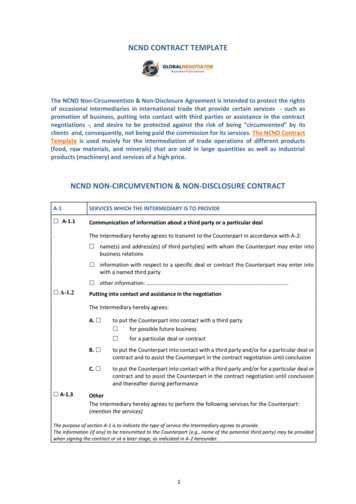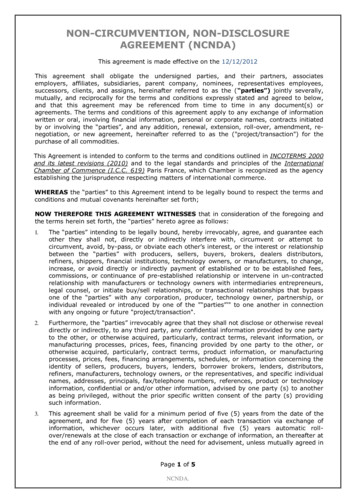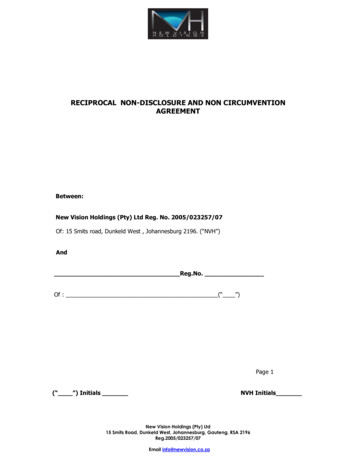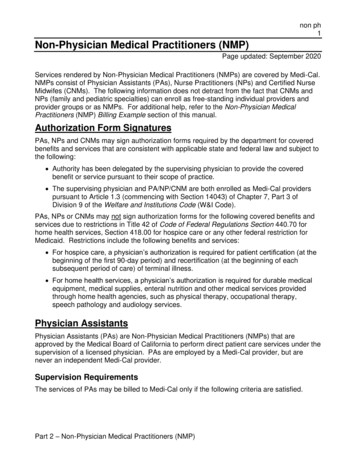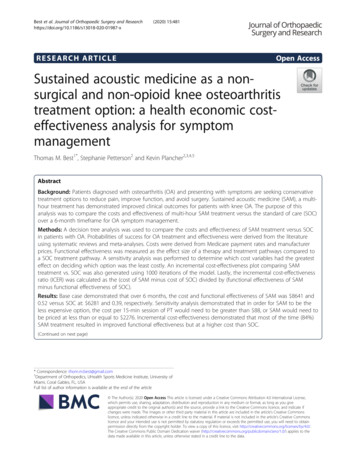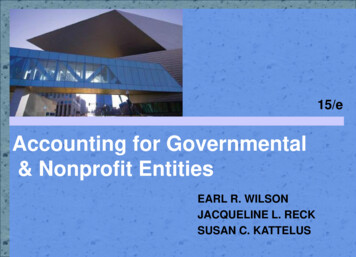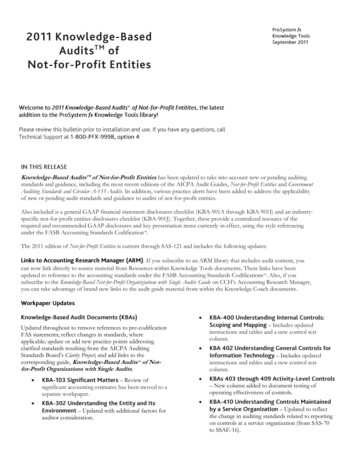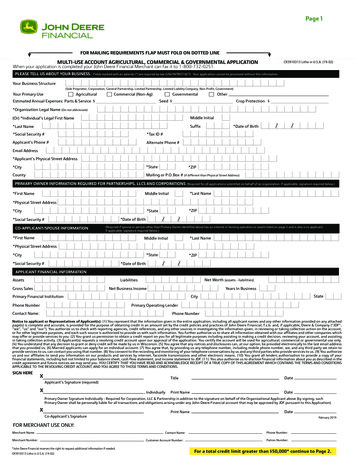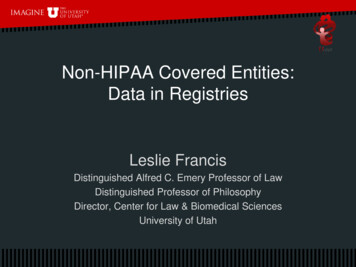
Transcription
Non-HIPAA Covered Entities:Data in RegistriesLeslie FrancisDistinguished Alfred C. Emery Professor of LawDistinguished Professor of PhilosophyDirector, Center for Law & Biomedical SciencesUniversity of Utah
Outline Non-HIPAA covered entities: primaryexamples Registries: types, data sources Some preliminary data about registriesand the inadequacy of protections
Non-HIPAA Covered Entities: Primary Examples Providers who do not have any records in electronicform (some counselors); near-providers (massagetherapists) Social media (e.g. Facebook; Patients Like Me) Web search history (e.g. WebMD) Wearables (e.g. FitBit) Personal record storage (e.g. exercise logs; calorieintake logs, PHRs) Recreational genetics (e.g. 23 and Me) Registries (e.g. CF Foundation Patient Registry)
Non-HIPAA Covered Entities: Why theProblem? Health information may be as detailed and as sensitive asinformation possessed by HIPAA-covered entitiesMay receive PHI from HIPAA-covered entities, without patientsrealizing that the PHI has been transferred or is no longer HIPAAprotectedProtections (primarily FTC, state law) uneven at best for somePrivacy policies often difficult to find, hard to readImportant provisions may be dispersed among Terms of Conditionsor at other places on the websiteUsers may have little information about or control over how data areused or transferred by these entities, especially if there has been arepresentation that data have been de-identified
The Social Media Argument: People like to sharebecause they judge they are getting benefits Fair enough, but . . . People may not realize what information isbeing collected, or how much, even on socialmedia. Many data transfers from HIPAA-coveredentities to non-HIPAA covered entities occurwithout either effective notice or choice forpatients Registries are an example
Registries Repositories of patient data collected forspecific purposes May be limited to patients with specificconditions (e.g. rare genetic diseases),specific known exposures (e.g. to a toxin),specific treatments (e.g cardiac device) May be funded from public , charitablecontributions, pharmaceutical companies,professional organizations
Registry Landscape: Vast Public health: tumors, birth defects Disease specific– Charitable (e.g., CF Foundation)– Pharmaceutical company sponsored (e.g.MastCell Connect for mastocytosis; sponsorblueprint Medicines) Patient generated (e.g. Genetic Alliance) Researcher-created (e.g. SEER) Medical association sponsored (e.g. ACC)
Data sources for registries Data originally collected for clinical care, inelectronic form, within the HIPAA-covered entity Data originally collected for clinical researchwithin the HIPAA-covered entity Data entered by patients themselves Data entered by family members of patients
Registry data collection and use May be by one-time patient consent to entry on anongoing basis May be by one-time surrogate consent to entry (e.g.parents); although many require adult consent tocontinuing data collection not all do May collect data directly from clinical records or frompatients themselves Typically require patient consent for participation inparticular studies using identifiable data, but not for usesor transfers of data in de-identified form May sell de-identified data to support registry operations
Identified or de-identified? Once de-identified, no longer HIPAA PHI Use of de-identified data not humansubjects research Risk of re-identification– Has been primary subject of discussionregarding de-identified data– But re-identification is not the only, or eventhe primary, concern
Concerns beyond re-identification Inferences from conjoined data sets– Novel or surprising– Stigmatizing– May apply to others not included in original data sets Uses of data that are disapproved– Sense of contribution to something that is wrong– Loss of identity Uses of data that could cause economic harm– Job costs for groups: changes in workplace policy– Benefits loss: redlining
Data Downstream: protections? If de-identified, typically an agreement not to re-identify If identified– Data use agreements– Patient authorization (HIPAA)– Patient consent (research data)– IRB review Enforcement? Contract law, laws applicable to certainpositions (e.g. public health employees, universityfaculty) How monitored? We don’t really know in many cases
Pilot study of registry governance NIH website list of registries Selected those with contact information,data collection on an ongoing basis: 59 Successful contact with 30; 20 agreed todiscuss governance Varied in size from 200 to 800,000participants IRB approved questionnaire
Preliminary findings: governance All registries had identified staff, decisionmaking bodies Only half had an advisory board or secondbody of advisors to guide technical,scientific, or ethical decision making Fewer than a third were transparent abouttheir decision-making process
Preliminary findings: privacy andsecurity Half of the registries publicly specified uses of thedata they were collecting Fewer than half permitted participants to accesstheir data One-third gave specific information about datastorage; this included one that stored data on agoogle format and another that stored data onservers outside of the US Only ONE registry had a protocol for addressingdata breaches
Acknowledgements Research reported in this publication was supported byUtah Center for Excellence in ELSI Research (UCEER).UCEER is supported by the National Human GenomeResearch Institute of the National Institutes of Healthunder Award Number P20HG007249 (orRM1HG009037). The content is solely the responsibilityof the authors and does not necessarily represent theofficial views of the National Institutes of Health I am grateful to Michael Squires, my UCEER RA, forinterviews with registries
Nov 28, 2017 · Utah Center for Excellence in ELSI Research (UCEER). UCEER is supported by the National Human Genome Research Institute of the National Institutes of Health under Award Number P20HG007249 (or RM1HG009037). The content is solely the responsibility of the authors and does not necessarily represent the official views of the National Institutes of .
